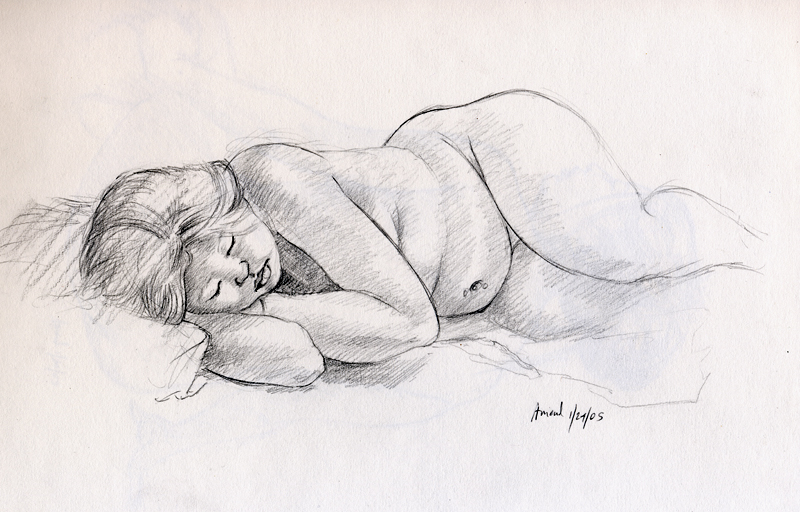Original post July 28.2010

For several years I helped to run weekly life drawing sessions at AVA, a local community art center. One night we had a young woman named Melissa modeling. It was her first time, and she was quite good, and we used her frequently for a couple of years. Most of our models dress and undress in the restrooms, but Melissa, for some reason, chose to undress just behind a curved wall that frames a small space in front of the two restrooms. I had gathered up the draperies from the shoved-together tables that we use for a modeling stand, and was on may way to put them away, when I noticed Melissa dressing behind the wall. My immediate impulse was to look away. feeling that I had intruded upon a private moment.
Now, this same young woman had been sitting for two hours, stark naked, before a half-dozen people, and I had spent that two hours looking very deliberately and with great concentration at her nude body. I’ve thought about this a lot, since. I do a lot of drawing from life, and it becomes fairly routine both for me and for the models, so why should I feel that seeing her dressing would be an intrusion?
Last Sunday I was at the Walker Art Museum in Minneapolis. In a show of work from the late 1960s there was a short film by Yoko Ono, from 1965, called “Cut Piece.” (I’ve always been a little ambivalent about Yoko; there’s that whole, legendary “Breaking Up the Beatles” thing, after all.) I caught the film already in progress, and when it ended, I watched it twice more.
Here’s the scenario: Yoko (quite young then) is sitting on a stage floor, dressed in a long-sleeved black sweater with white buttons, a skirt, and fishnet stockings. Her legs are folded demurely to the side, and she leans on one hand. Her face is composed. A pair of scissors is on the floor in front of her. As she sits passively, people from the audience approach her, pick up the scissors, and snip away bits of her clothing. At first, the snippings are tentative and small: a wedge of sleeve, a snipped-off button, but they rapidly progress in their aggressiveness. Rather quickly, her sweater is cut away, and then her slip. One quick, anxious bite of her lower lip momentarily breaks her composure, and a couple of times her eyes flicker for a second toward the cutter, but otherwise her face and posture remain composed and passive.
Finally, a young man snips through the straps of her bra, at which point her hands come up in an instinctively defensive move, to hold her bra in place. The camera slides suddenly to the side, and the film ends.
Each time I watched this film, I grew more uneasy. It felt as if I were witnessing an act of violence, of violation. And, increasingly, it felt as if I were progressing from voyeur to participant in that violence. But these musings aren’t about violence. They are, I think, about what is offered, and what is taken, and about how we continually do violences both large and small by our confusion about what and how things are offered and the subtle differences between receiving and taking. It’s easy to mistake one’s own need for the willingness of another’s offering.
When a model sheds the usual defenses of clothing, she (or he) puts other defensive mechanisms in place. Modeling nude is hard work, both physically and emotionally. Occasionally we get a model who cannot find those inner defenses, and is profoundly uncomfortable, and elects not to continue. When Melissa was dressing, she had relaxed those defenses. Her nudity had been offered; the private moment of her dressing had not.
The film by Yoko is, of course, a different case. Her defenselessness is artificial; it is, after all her performance we are witnessing. I suspect that the brief, anxious flaws in her composure were genuine, but the fact remains that a performance piece is just that: a performance. All of art is artifice. As Picasso said, “Art is a Lie, which helps us find the truth.” Good art evokes genuine responses by the power of artifice.
I was moved by this piece. Thanks, Yoko.
